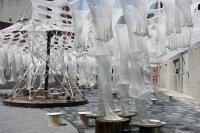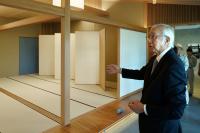Sa House
Niigata, Japan
The project site is located in an old rural settlement near Kameda station in Konan ward, Niigata, Japan. The area has relatively recently started the process of renewal, transitioning into a dense residential area. As the development progresses, the form and the location of waterways and roads modify; generating ever changing plot characteristics.
Conventionally, a single estate would contain an assemblage of buildings such as the main manor, a granary and farm land. And even though the roads of the village were narrow, each residence contained a buffer space; the link between daily living and the agricultural work. Through this, every estate was connected to the village nurturing a strong community bond. This project site was also previously such a site, possessed with agricultural, waterway - road and buffer area.
Currently, these plots are being subdivided and sold. This has generated a settlement where each house is connected to a narrow road without any buffer space, forming densely packed homes, all closely surrounded by neighbors. This is slowly depleting the essence of the village and the people's connection to it.
With this understanding, we planned a house where the clients and their children could live in harmony with the context.
What was required from the design?
1. A house in which the mother can overlook all the activities happening in the house, from the kitchen.
2. A house that both captures, wind and sunlight, and protects it from their harshness.
3. The ability to open up the building and create bright open living spaces inside.
The design of the building is an assemblage of small parts coming together to make a whole. The first floor has a compact design of distinct functions, while the design of the larger second floor originates from a facsimile of a slightly pivoted windmill. The voids originating from these blades, house the stairwell and terraces. Reminiscent of the aboriginal buffer space; these communal spaces allow people to come out and form a connection with the outside. A connection between the ‘neighborhood and home’, ‘outdoor and indoor’, ‘far and near’. It also becomes a filter to the harshness of the climate whilst providing privacy from neighbors.
In the center of the windmill is a chimney shaped skylight, which permeates the soft northern light to every corner of the house, as well as directs wind flow within the interior space to create efficient ventilation.
The changing ceiling heights and floor level create a variance in the light quality filtering into the different spaces. The children’s room adjoins the LDK, which is a flexible space. This flexible space provides people the ability to choose and manipulate the kind of space they require. This area is visible from the kitchen, under the watchful eye of the mother.
In addition, the house divides the elevation into smaller pieces and, using various materials gives a rich-deep look to the façade. Beyond just sustainability, this project delves into the diversity of its setting, gathering small parts to bring together and give depth to the current townscape; connecting the past and the future.
















